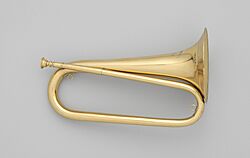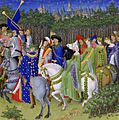Bugle facts for kids

A bugle in the key of C
|
|
| Brass instrument | |
|---|---|
| Classification | |
| Hornbostel–Sachs classification | 423.121.22 (Natural trumpets – an aerophone, meaning it makes sound from vibrating air. The player's lips make the air vibrate directly. The lips are the only way to change the sound's pitch. The instrument is a tube, and the player blows into its end. The tube is bent or folded, and it has a mouthpiece.) |
| Developed | Ancient times; modern types from the 1600s |
| Playing range | |
 |
|
| Related instruments | |
| More articles or information | |
|
|
The bugle is a very simple brass instrument. Unlike a trumpet, it has no valves or other moving parts. The only way a player can change the pitch (how high or low the sound is) is by changing the shape of their lips. This means that only certain notes, called harmonic series notes, can be played on a bugle.
Contents
History of the Bugle
The bugle developed from instruments made from animal horns. The first bugles were often shaped in a loop, like a modern French horn. They were mainly used to send messages during hunts. Older instruments related to the bugle include the post horn and the Pless horn.
The first time a brass horn was used for military signals was in 1758. This instrument was called the Halbmondblaser, meaning "half-moon blower." It was U-shaped and easy to carry with a strap. This instrument first came to England in 1764. Over time, foot soldiers began to use it often. Cavalry (soldiers on horseback) usually used an early trumpet instead. Trumpets made a sound that was easier to hear nearby, but it did not travel as far.
How Bugles Are Used
Bugles are mostly used in the military today. They are used to play bugle calls, which are short musical signals. These calls announce different events, like waking up, meal times, or lights out. Long ago, bugles helped officers give instructions to soldiers during battles. The Bible also mentions bugles. In the book of Numbers, God told Moses to make two bugles of hammered silver. These were used to gather leaders and give marching orders.
In drum and bugle corps, the bugle has changed a lot from its military past. Modern bugles used in these groups now have valves. In American drum and bugle corps, the key of G was traditionally used for bugles. However, today's rules allow bugles in any key, with zero to four valves. They also have a bell that faces forward.
Civilian drum corps started in the early 1900s. They used instruments sold by the military. Before the radio was invented, the last change to military bugles was to make them all play in the key of G. Bugles in other parts of the world used to be in B flat or E flat.
The bugle is also used by the Boy Scouts. They use some of the same bugle calls as the military.
Different Types of Bugles
The cornet is sometimes mistakenly called a "valved bugle." However, it actually comes from the French cornet de poste, which means "post horn."
In the 19th century, new versions of the bugle were made. These had keys and valves. Keyed bugles were invented in England in the early 1800s. Joseph Halliday patented one design, called the Royal Kent bugle, in 1811. This bugle was very popular until about 1850. For example, it was used in music by Richard Willis, who later led the band at the United States Military Academy at West Point. This type of bugle became less common when the valved cornet was invented.
Many modern instruments that are called bugles today have valves.
Bugle Pitches
- Soprano bugle (high pitch)
- Alto bugle (medium pitch)
- Baritone bugle (tenor pitch)
- Contrabass bugle (bass pitch)
Images for kids
-
A Roman bugle from the 4th century. It was found in France and is now in the British Museum.
-
An American poster from the Second World War showing a bugler from the Ethiopian National Defence Force Band.
See also
 In Spanish: Corneta natural para niños
In Spanish: Corneta natural para niños












